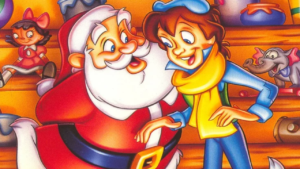Description
The Night Before Christmas1840
The Night Before Christmas, also known by its opening line, ‘Twas the Night Before Christmas, is one of the most famous poems associated with the Christmas holiday. Originally published anonymously in 1823, the poem was later attributed to Clement Clarke Moore, who claimed authorship in 1837. It has since become an enduring part of Christmas tradition, shaping much of the modern-day imagery and lore surrounding the holiday, particularly in regard to Santa Claus. Through its lively rhythm, joyful tone, and vivid imagery, this beloved poem has captured the hearts of generations, providing an essential narrative for the holiday season.
Origins and Authorship
The poem was first published anonymously on December 23, 1823, in The Sentinel, a New York newspaper. Under the title Account of a Visit from St. Nicholas, it quickly became popular, and its familiarity spread across the United States. For many years, the poem’s author remained unknown, and it was even misattributed to various writers and poets. However, in 1837, Clement Clarke Moore, a professor of divinity and theology at the General Theological Seminary in New York, publicly claimed authorship of the poem. Moore’s connection to the poem remains widely accepted, despite some ongoing debate among scholars over whether he was truly the author or whether the poem might have been written by someone else, potentially Henry Livingston Jr.
While Moore’s authorship has become definitive in most literary circles, the poem’s initial anonymous publication only added to its mystique and enduring popularity. Regardless of authorship, The Night Before Christmas has remained an important part of American holiday traditions.
The Structure and Content of the Poem
The poem is written in rhymed couplets, with a consistent AABB rhyme scheme that gives it a rhythmic, almost musical flow. This structure makes the poem easy to memorize and recite, which has contributed to its widespread oral tradition. The poem’s language is simple and accessible, yet it manages to evoke a rich and magical atmosphere, perfect for children and adults alike.
The poem opens with the famous line, “’Twas the night before Christmas, when all through the house, not a creature was stirring, not even a mouse.” This opening sets the stage for a peaceful, quiet night, with everyone in the household asleep. It creates a contrast to the extraordinary events about to unfold, as the reader is transported into a world of holiday magic.
The central narrative of the poem is a description of Santa Claus’s visit to a home on Christmas Eve. The protagonist of the story is the father, who is awake and watching the events unfold. Santa is depicted as a jolly, round, and bearded figure with a sleigh pulled by eight reindeer. The poem also introduces iconic elements of Santa’s visit, including the chimney, where Santa descends with gifts for the children, and his trademark laugh: “Ho, ho, ho!”
The poem also introduces the names of Santa’s reindeer, many of which have become part of the popular Christmas lexicon: Dasher, Dancer, Prancer, Vixen, Comet, Cupid, Donder (often misheard as Donner), and Blitzen. The inclusion of these names, along with the description of Santa’s sleigh and reindeer, helped solidify many of the images associated with modern Santa Claus.
Themes and Imagery
At its core, The Night Before Christmas is a celebration of the magic and wonder of Christmas Eve. The poem conveys a sense of anticipation and joy, capturing the essence of holiday excitement as children eagerly await Santa’s arrival. This theme of anticipation is reinforced by the father’s observations as he watches Santa enter the house, placing gifts under the tree and filling stockings.

One of the most endearing aspects of the poem is its depiction of Santa Claus, who is portrayed as a jolly, kind, and magical figure. His character is largely shaped by Moore’s description, which emphasized the cheerful, chubby, and mischievous qualities that have since become synonymous with the modern Santa Claus. Santa is not just a gift-bringer; he is a magical and joyful figure, embodying the spirit of Christmas. His visit brings a sense of joy, wonder, and kindness to the home, reinforcing the holiday’s emphasis on giving and goodwill.
In addition to Santa, the poem is full of other vivid imagery that has become central to the modern Christmas narrative. The descriptions of the stockings hung by the chimney with care, the twinkling eyes of Santa, and the sled and reindeer flying through the sky have all become iconic elements of the Christmas tradition. These elements were not as fully formed before the poem, and Moore’s vivid portrayal helped define many of the symbols associated with the holiday.
Impact and Legacy
Since its publication, The Night Before Christmas has had a profound influence on Christmas culture. The poem helped solidify the modern image of Santa Claus, including his appearance, behavior, and methods of gift delivery. Prior to Moore’s poem, Santa Claus was often depicted as a more austere figure, and his image varied widely depending on the region and artistic depiction. Moore’s version, however, presented a fun, jolly, and distinctly American Santa, which resonated with readers and eventually became the template for all future representations.
The poem also played a significant role in shaping the concept of Christmas Eve as a time of anticipation and magical expectation. Today, many families read the poem aloud on Christmas Eve as part of their holiday traditions. Its enduring popularity is a testament to its universal appeal and timeless themes of joy, wonder, and generosity.
Beyond its role in shaping the modern-day Santa Claus, the poem has inspired countless adaptations in various forms of media, including films, TV specials, and even stage productions. It remains one of the most-recited and beloved poems in the English-speaking world, and its influence on Christmas culture is undeniable.
Conclusion
The Night Before Christmas, originally published as Account of a Visit from St. Nicholas in 1823, has become a cornerstone of Christmas tradition. Through its enchanting language, vivid imagery, and joyful depiction of Santa Claus, the poem captures the magic and spirit of Christmas like no other. While it has undergone various adaptations and changes over the years, the core message of hope, love, and celebration remains the same. Today, the poem continues to bring joy to families around the world, making it one of the most enduring and cherished works of literature in the holiday season.






Reviews
There are no reviews yet.